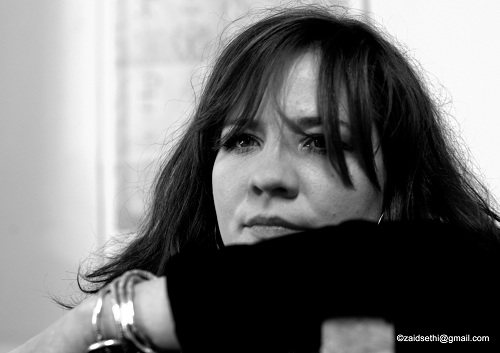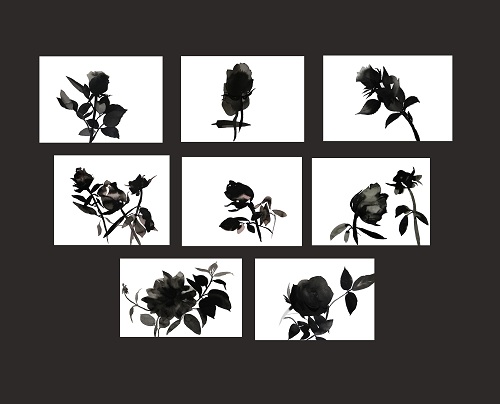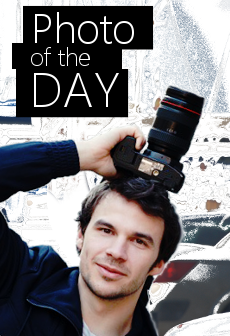An interview with the Hungarian artist Annamária Őry by Anelia Stoyanova

Hello Annamaria. Please introduce yourself in a few words?
I graduated at the Academy of Fine Arts in Budapest as a painter at 2006. I have diverse activities in oil painting, pastel and waterproof ink, as well as in aquarelle painting.
I’m deeply interested in exploring the various possibilities offered by the different techniques, examining these in depth, whilst committing myself to a specific subject and painting technique. Most of the time, the technique used stands in close relationship with an adequate thematic object.
This results in a series of paintings focusing on a selected topic and exploring a specific theme. Thinking in series offers me the option of continuousness and the further works to develop the selected theme upon. There is no closure. There are problem areas to explore, and different answers to give…
I have received several scholarships, of which the most important was the one in 2009 by the Hungarian Academy in Rome. Her major exhibitions of the past period took place in the Hungarian Cultural Institute in Prague (2009), Hungarian Academy in Rome (2009), MODEM Debrecen (2010), Hang Bai exhibition space, Hanoi Vietnam (2010), Hungarian Cultural Centre Brussels (2010), European Parliament Brussels (2010) and several other activities in the past 3 years.
When did you start painting?
My relationship with Painting is original because of my mother, who is also a painter. I was growing up in her studio, and I learnt a lot from her during my study period.
How do you define your painting style?
In my opinion painting is not just a conception because you use material. In my painting style the most important thing is what the perfect way to impress something what is based on experiences, emotions, and thoughts is. I’ve got the classical technical studies, but I think people can learn and improve he or herself during the period of life.
What is art for you personally? What do you think is its role in our world?
I think Art has many dimensions, and forms, and it defines the place of that in the world. There is art that’s target is delighting, there is art which is entertaining, art which shows the truth like a mirror and art which is transforming something transcendental, spiritual into the material.
All of them have a function that puts the person from the static state of mind or transforms the pain for something of beauty.
Your exhibition “Metamorphoses of Rose” started on April 15 in the Hungarian Cultural Institute, Sofia. Why did you choose the Bulgarian public to exhibit your paintings?
When I first became interested in the symbol of the Rose, I first of all collected all of the information about the symbol. It doesn’t mean information just from books, but from life…from everything.
Focusing on one symbol is sometimes a way of passion, because you start to see everything throughout the picture what you have put into your soul. At one point, I was interested in the smell of the Rose.
I followed this route and I have found Bulgaria. So I thought: I had to go to visit this country because they must know a lot of secrets about this flower, growing up a rose field and making oil from that is a huge experience – tradition and knowledge about the rose, more than just thinking of that.
Another reason, I have written a short novel from a Bulgarian writer, Vladi Kirov, which I really loved, and I have some half Bulgarian, half Hungarian musician friends, so that is my inspiration.
What would you like to present to the visitors of the exhibition? What would you like to say them?
I would like to say to them: spend some minutes with the pictures, forget everything and focusing on their own inner imaginations, feelings and emotions, with an open minded approach.
A Rose is a flower with so many different meanings. What does it symbolize in your paintings?
In my paintings the Rose is the essence of the desire, so it’s an original secret, a mysticism of life and death.
What other symbols do you use in your works?
I have a series about fishes, and hearts, windows, and mandalas-central forms. Everything is connecting with everything…
“Metamorphoses of Rose” is a part of series about the heart. Would you tell us something more about that?
When I started to paint the heart series, I was wandering about the nature of the heart in a way of associations. I had an image that the heart is a seed…
I was wondering, ‘If the heart is really a seed how does it grow? Is there a direction to its growth? Dimension of its growth? What are its leaves like?’ I remembered a poem about a blue lotus, whose roots rose out of the mud and it bloomed above the surface of the water.
It had five petals and the leaves grew in a mysterious, hidden way. I thought the heart could be something similar to this, and this recognition stopped any further illusions. So later I have defined the Rose, which symbolizes a similar thing in the European culture.
Do you think about the Bulgarian public? How did it perceive your exhibition?
I think The Bulgarian public has a really curious nature, and a deep understanding.

Do you already have plans for new projects and exhibitions?
This exhibition is going to move to Burgas at June, and I’m working on other variations of the Rose subject which you can see in Berlin at the Hungarian Cultural Center from 27 – end of September.
What would you like to tell the readers of Public Republic?
If they can, visit the exhibition in the Hungarian Cultural Center in Sofia, or in Burgas during the summer period.

Annamária Őry
I was born in Budapest, Hungary at 1980. 09. 13
Education:
2001-2006 Hungarian Academy of Fine Arts, Budapest, Hungary, majoring in Painting
Professor: Attila Kovács and József Gaál Phd
2005 Edinburgh College of Art. Painter department
1996-2000 Hungarian Secondary School of Fine Arts. Painter departmant
1995-1996 Bródy Imre Secondary School. Visual arts departmentselected solo shows:
2013 CHB. 16 Aszkarov s. Sofia 1000 BUL
2012 Symbol art gallery , Budapest. HUN
ROVÁS Kmeťova 34, 04001 Kosice. SVK
2009 Hungarian Cultural Center, Prague. CZE
2008 Gallery of Ferencváros, Budapest. HUN
2008 Chinese Characters of contemporary art, Budapest. HUN
2007 Gallery K.A.S. Budapest. HUNselected group shows
2013 Rondella Gallery Esztergom , HU
Lukijan Mušicki MTK museum Temerin, SRB
Museum of Art and History, Eger , HUN
2012 Rondella Gallery Esztergom , HUN
Museo Internazionale Design Ceramico. Laveno-Mombello.ITA
Caos Art Gallery. Venezia. ITA
2011 Arsenal. Wroclaw. POL
HCB Brussels. BEL
Kaleidoscope House Esztergom. HUN
Vaulted Gallery Budapest. HUN
European Parliament. Brussels. BEL
2010 Hungariarian Cultural Center. Brussels. BEL
Friss Galery Budapest. HUN
Cultural Youth Center 5.dist. HCM City. VIE
Phong Trien lam tranh 29 Hang Bai. Hanoi. VIE
MODEM. Modern and Contemporary Art Center. Debrecen. HUN
2009 Hungariarian Cultural Center. Prague. CZE
Duna Gallery. Budapest. HUN
The Wall. Hungarian Academy in Rome. Rome. ITA
Spazi Aperti. Rome. ITA
Tendencies. Museum of Balaton. Szekszárd. HUN
2008 New Body. The day of painting 2008. Kopaszi Gát. Budapest. HUN
V. Painting Triennal. Szekszárd. HUN
Piknik Fest. Esztergom. HUN
Definitive Adventure.Gallery of National Dance Theatre.Budapest. HUN
2007 S.Y.L.A. Gallery. Bonn. GER
Protop Art Gallery. Budapest. HUN
Summer/Time Hegyvidék Gallery. Budapest.HUN
Chinese Characters of contemporary art, Budapest. HUN
Tendencies III. Biennal. Szekszárd. HUN
2006 Exhibition House 29. Hang Bai. Hanoi. VIE
Best of Diploma. Barcsay Hall. Budapest. HUN
Biennal of Young Artists. Art Mill. Szentendre. HUN
2005 Tűzraktár. Independent Cultural Center. Budapest. HUN
Edinburgh College of Art. Edinburgh. GBR
2004 The Iwano Project 5.Muzej 25, Belgrade. SRB
2003 The Iwano Project 4. Novi Sad. SRB
1997 Art colony. Gyergyószárhegy. ROUArtistic Experience:
I had several exhibitions and projects with artist from different countries.
2010 I was the organizer of the exhibitions of the Hungarian and Vietnamese artists in Hanoi and HCM city inVietnam. I could meet and change ideas with several contemporary Vietnamise artists across Vietnam. It was a huge experience to see how they use the traditional and new media tequniques in the contamporary way,and see several artists behave and art in the present situation.
2009 During my residency program in Rome, I studied the base of the Europien culture and art tradition. Especially the anciant Roman, Greek,and Etruscan culture.
2005 I spent half year in Schotland, and I had a relationship with the celtic art tradition and contamporary movemants.
Prize Fellowships
2009/2010 NKA prize fellowship
2008 Hungarian Academy, Rome ITA
2005 Erasmus, Edinburgh GBR
Memberships
2009 Caffard.Association of Hungarian Painters
2007 Association of Hungarian Fine and Applied Artists
2007 Association of Hungarian PaintersContact
1143 Ilka.u. 49 Budapest. Hungary
orymarcsi@gmail.com
0036 20 2796421
http://oryannamaria.hu/











No comments so far ↓
Nobody has commented yet. Be the first!
Comment